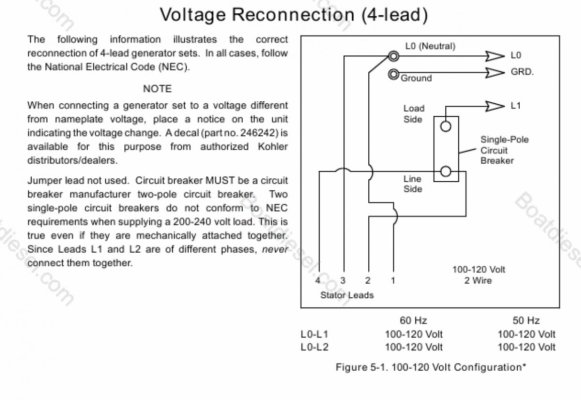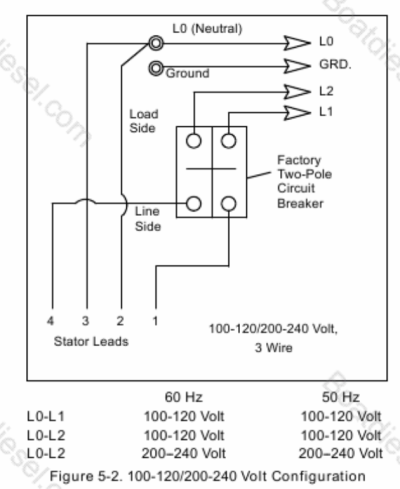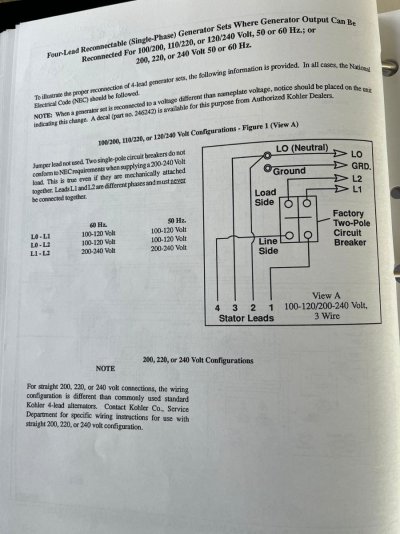stevemitchell
Guru
- Joined
- Sep 25, 2018
- Messages
- 542
- Location
- USA
- Vessel Name
- Aruna
- Vessel Make
- Kristen Yachts 50 Pilot House
I have a Kohler 11CCFOZ/13.5CCOZ marine generator that I am struggling with changing from 120v to 240v. The reason I say 11CCFOZ/13.5CCOZ is that the generator was mis-labeled when the boat was built (according to the previous owner) - the 11CCFOZ is a 50hz unit, and the 13.5CCOZ is 60hz. At some point the unit was "converted" to 60hz since the boat has always been in the US and used on 60hz power. I mention this only in case there is some history or limitation with the 11CCFOZ, but I don't think there is.
The unit is currently producing 120v AC @ 60hz and can pump out close to 100 amps of power. It also has a three pole, with only one pole being used for the hot L1, 100 amp output breaker that looks original.

The specs say that this generator can output 120 or 240 volts, single phase. I'm trying to use it with a split phase set of inverters and need two different legs of 120v @ 60hz to each of them.
I have a neighbor with what appears to be the same exact generator that is already setup this way. I have confirmed the wiring on his matches the wiring I switched mine to.

From the Installation and Operations manual, this is how the voltage connections are right now to produce 120v AC (picture above).

I have tried wiring it up like the above diagram, also from the operations and installation manual. This should give me two separate legs of 120v, but it doesn't. Instead, I get a pulsing amount of voltage ranging from 60v-130v (or sometimes higher or lower) depending on how I adjust the voltage regulator.
I've followed the process to adjust the voltage regulator several times, and never seem to be able to stabilize the voltage on either leg. I can see the lights on the voltage regulator and on the control board pulsing as the voltage goes up and down.

The unit has the Powerboost voltage regulator, board B-258296, and when I flip it back to 120v it works just fine (after a quick adjustment).
I'm trying to determine whether it is even possible to produce 240v out of this set. I would think it would be since most all generators I've ever set hands on use a similar setup where you can convert them between 50/60hz and 120/240 volts with wiring and some patience.
I'm at a loss as to why I can't do it with this model, and am beginning to think there is a board or component that limits this unit to 120v, or I am being super stupid and forgot to do something.
The unit is currently producing 120v AC @ 60hz and can pump out close to 100 amps of power. It also has a three pole, with only one pole being used for the hot L1, 100 amp output breaker that looks original.

The specs say that this generator can output 120 or 240 volts, single phase. I'm trying to use it with a split phase set of inverters and need two different legs of 120v @ 60hz to each of them.
I have a neighbor with what appears to be the same exact generator that is already setup this way. I have confirmed the wiring on his matches the wiring I switched mine to.

From the Installation and Operations manual, this is how the voltage connections are right now to produce 120v AC (picture above).

I have tried wiring it up like the above diagram, also from the operations and installation manual. This should give me two separate legs of 120v, but it doesn't. Instead, I get a pulsing amount of voltage ranging from 60v-130v (or sometimes higher or lower) depending on how I adjust the voltage regulator.
I've followed the process to adjust the voltage regulator several times, and never seem to be able to stabilize the voltage on either leg. I can see the lights on the voltage regulator and on the control board pulsing as the voltage goes up and down.

The unit has the Powerboost voltage regulator, board B-258296, and when I flip it back to 120v it works just fine (after a quick adjustment).
I'm trying to determine whether it is even possible to produce 240v out of this set. I would think it would be since most all generators I've ever set hands on use a similar setup where you can convert them between 50/60hz and 120/240 volts with wiring and some patience.
I'm at a loss as to why I can't do it with this model, and am beginning to think there is a board or component that limits this unit to 120v, or I am being super stupid and forgot to do something.

